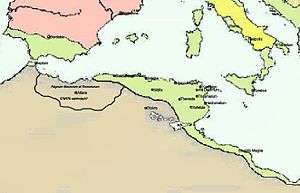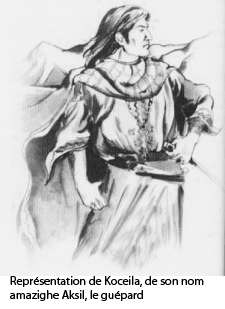Kingdom of Altava

The Kingdom of Altava was an independent Berber Christian kingdom centered in the ancient province of Mauretania Caesariensis, located in present-day northern Algeria. It was ruled by kings like Masuna (508), Mastigas (535-540), Garmul (560s-579),[1] and Caecilius (680-690).[2]
History
The Kingdom of Altava existed in the Tamazgha from the 4th century AD until the death of Caecilius in 690 AD. It was originally known as the Mauro-Roman kingdom.

King Masuna was among the more important Altava rulers. He was described in an inscription from his capital Altava (modern Ouled Mimoun, Tlemcen) dated to 508 AD as a king of Berbers and Romans and mention is made of his officials including Masguinus the prefect of Safar, Maximus the procurator of Altava and lider the procurator of Castra Severiana.[3]
The Western kingdom more distant from the Vandal kingdom was the one of Altava, a city located at the borders of Mauretania Tingitana and Caesariensis....It is clear that the Mauro-Roman kingdom of Altava was fully inside the Western Latin world, not only because of location but mainly because it adopted the military-religious-sociocultural-administrative organization of the Roman Empire...[4]
Caecilius/Kusaila (Aksil, meaning the "leopard" in Berber), was the last ruler of the Altava kingdom. He died in the year 690 AD fighting the Umayyad Caliphate. Caecilius was a 7th-century Berber Christian king of this kingdom of Altava and leader of the Berber Awraba tribe and possibly Christian head of the Sanhaja confederation. He is known for prosecuting an effective Berber military resistance against the Muslim conquest of the Maghreb in the 680s. In 688 AD Muslim reinforcements arrived under Zuhair ibn Kays. Caecilius met them in 690 AD (supported even by byzantine troops) at the Battle of Mahmma, 50 km west of the just founded Kairouan. Vastly outnumbered, the Awraba were defeated and Caecilius was killed. With the death of Caecilius, the torch of resistance passed to a tribe known as the Jerawa tribe, who had their home in the Aurès Mountains: his troops after his death fought later under Kahina, the last Queen of the romanized Berbers.
See also
References
- ↑ Reynolds, Paul (2010). Trade in the western Mediterranean, AD 400-700, 439-700. University of Michigan: Tempus Reparatum, 1995. p. 139. ISBN 0860547825.
- ↑ Noé Villaverde Vega: "El Reino mauretoromano de Altava, siglo VI" [The Mauro-Roman kingdom of Altava], Tingitana en la antigüedad tardía, siglos III–VII: autoctonía y romanidad en el extremo occidente mediterráneo (Madrid: 2001), p. 355
- ↑ Conant, Jonathan (2004), "Literacy and Private Documentation in Vandal North Africa: The Case of the Albertini Tablets", Vandals, Romans and Berbers: New Perspectives on Late Antique North Africa, Ashgate Publishing, pp. 199–224, ISBN 0-7546-4145-7
- ↑ Noé Villaverde, Vega: "El Reino mauretoromano de Altava, siglo VI" (The Mauro-Roman kingdom of Altava) p.355
Bibliography
- Camps, G. Rex gentium Maurorum et Romanorum. Recherches sur les royaumes de Maurétanie des VIe et VIIe siècles
- Hrbek, I., ed. General History of Africa III: Africa From the Seventh to the Eleventh Century.
- Modéran, Y. Kusayla, l'Afrique et les Arabes. In "Identités et Cultures dans l'Algérie Antique", University of Rouen, 2005 (ISBN 2-87775-391-3).
- Conant, Jonathan (2012). Staying Roman : conquest and identity in Africa and the Mediterranean, 439-700. Cambridge New York: Cambridge University Press. pp. 280–281. ISBN 0521196973.